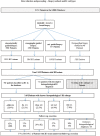Lesions with unclear malignant potential (B3) after minimally invasive breast biopsy: evaluation of vacuum biopsies performed in Switzerland and recommended further management
- PMID: 26552694
- PMCID: PMC4906532
- DOI: 10.1177/0284185115610931
Lesions with unclear malignant potential (B3) after minimally invasive breast biopsy: evaluation of vacuum biopsies performed in Switzerland and recommended further management
Abstract
Background: Histopathological B3 lesions after minimal invasive breast biopsy (VABB) are a particular challenge for the clinician, as there are currently no binding recommendations regarding the subsequent procedure.
Purpose: To analyze all B3 lesions, diagnosed at VABB and captured in the national central Swiss MIBB database and to provide a data basis for further management in this subgroup of patients.
Material and methods: All 9,153 stereotactically, sonographically, or magnetic resonance imaging (MRI)-guided vacuum-assisted breast biopsies, performed in Switzerland between 2009 and 2011, captured in a central database, were evaluated. The rate of B3 lesions and the definitive pathological findings in patients who underwent surgical resection were analyzed.
Results: The B3 rate was 17.0% (1532 of 9000 biopsies with B classification). Among the 521 lesions with a definitive postoperative diagnosis, the malignancy rate (invasive carcinoma or DCIS) was 21.5%. In patients with atypical ductal hyperplasia, papillary lesions, flat epithelial atypia, lobular neoplasia, and radial scar diagnosed by VABB, the malignancy rates were 25.9%, 3.1%, 18.3%, 26.4%, and 11.1%, respectively.
Conclusion: B3 lesions, comprising 17%, of all analyzed biopsies, were common and the proportion of malignancies in those lesions undergoing subsequent surgical excision was high (21.5%).
Keywords: B3 lesion; Breast cancer; ductal carcinoma in situ (DCIS); invasive carcinoma; uncertain malignant potential; vacuum-assisted breast biopsy.
© The Foundation Acta Radiologica 2015.
Figures
Similar articles
-
Positive predictive value for malignancy of uncertain malignant potential (B3) breast lesions diagnosed on vacuum-assisted biopsy (VAB): is surgical excision still recommended?Eur Radiol. 2021 Feb;31(2):920-927. doi: 10.1007/s00330-020-07161-5. Epub 2020 Aug 20. Eur Radiol. 2021. PMID: 32816199 Review.
-
Flat epithelial atypia is a common subtype of B3 breast lesions and is associated with noninvasive cancer but not with invasive cancer in final excision histology.Hum Pathol. 2010 Apr;41(4):522-7. doi: 10.1016/j.humpath.2009.09.005. Epub 2009 Dec 11. Hum Pathol. 2010. PMID: 20004938
-
High-risk lesions diagnosed at MRI-guided vacuum-assisted breast biopsy: imaging characteristics, outcome of surgical excision or imaging follow-up.Breast Cancer. 2020 May;27(3):405-414. doi: 10.1007/s12282-019-01032-8. Epub 2019 Dec 14. Breast Cancer. 2020. PMID: 31838725
-
Second International Consensus Conference on lesions of uncertain malignant potential in the breast (B3 lesions).Breast Cancer Res Treat. 2019 Apr;174(2):279-296. doi: 10.1007/s10549-018-05071-1. Epub 2018 Nov 30. Breast Cancer Res Treat. 2019. PMID: 30506111 Free PMC article. Review.
-
High-risk lesions at MRI-guided breast biopsy: frequency and rate of underestimation.AJR Am J Roentgenol. 2014 Sep;203(3):682-6. doi: 10.2214/AJR.13.11905. AJR Am J Roentgenol. 2014. PMID: 25148176
Cited by
-
B3 Lesions at Vacuum-Assisted Breast Biopsy under Ultrasound or Mammography Guidance: A Single-Center Experience on 3634 Consecutive Biopsies.Cancers (Basel). 2021 Oct 29;13(21):5443. doi: 10.3390/cancers13215443. Cancers (Basel). 2021. PMID: 34771606 Free PMC article.
-
Lesion characteristics, histopathologic results, and follow-up of breast lesions after MRI-guided biopsy.Diagn Interv Radiol. 2017 Sep-Oct;23(5):333-338. doi: 10.5152/dir.2017.17004. Diagn Interv Radiol. 2017. PMID: 28830847 Free PMC article.
-
Upgrade rates of high-risk breast lesions diagnosed on core needle biopsy: a single-institution experience and literature review.Mod Pathol. 2016 Dec;29(12):1471-1484. doi: 10.1038/modpathol.2016.127. Epub 2016 Aug 19. Mod Pathol. 2016. PMID: 27538687 Review.
-
First International Consensus Conference on lesions of uncertain malignant potential in the breast (B3 lesions).Breast Cancer Res Treat. 2016 Sep;159(2):203-13. doi: 10.1007/s10549-016-3935-4. Epub 2016 Aug 13. Breast Cancer Res Treat. 2016. PMID: 27522516 Free PMC article.
-
Surgical implications and variability in the use of the flat epithelial atypia diagnosis on breast biopsy specimens.Breast. 2017 Aug;34:34-43. doi: 10.1016/j.breast.2017.04.004. Epub 2017 May 3. Breast. 2017. PMID: 28475933 Free PMC article.
References
-
- Ellis IO, Michell M, Pinder SE, et al. Guidelines for non-operative diagnostic procedures and reporting in breast cancer screening, London: NHSBSP, 2001.
-
- Andreu FJ, Sáez A, Sentís M, et al. Breast core biopsy reporting categories–An internal validation in a series of 3054 consecutive lesions. Breast 2007; 16: 94–101. - PubMed
-
- Zenklusen, Dirnhofer, Bubendorf, et al. Qualitätsrichtlinien der schweizerischen Gesellschaft für Pathologie SGPath [in German]. 2011. Available at: http://www.sgpath.ch/docs/QR_SGPath_DE_2011.pdf.
-
- Köchli O R, Rageth J C, Brun del Re R, et al. Bildgesteuerte minimalinvasive Mammaeingriffe: Konsensusstatements für die Schweizerische Gesellschaft für Senologie (SGS) und die Arbeitsgruppe Bildgesteuerte minimalinvasive Mammaeingriffe [in German]. Senologie - Zeitschrift für Mammadiagnostik und therapie 2009;6:181–184. Available at: http://www.mibb.ch/Documents/Seno_3-09_S181-184_Rageth.aspx.
MeSH terms
LinkOut - more resources
Full Text Sources
Other Literature Sources
Medical


